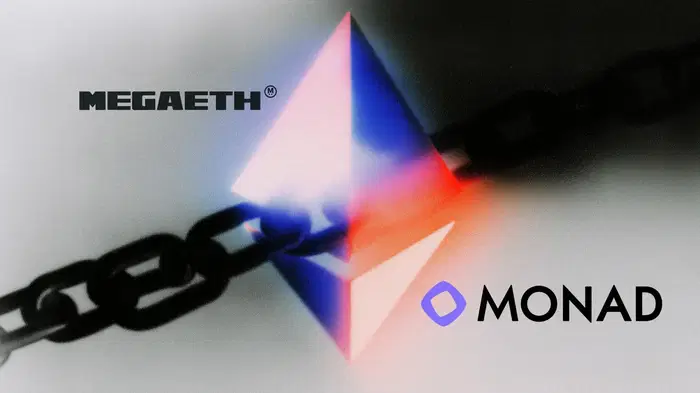
Subscribe to Bankless or sign in
Ethereum’s arteries can often feel a bit clogged.
Despite its decade of dominance in onchain infrastructure, the world’s most battle-tested smart contract network struggles to process user transactions for an affordable cost under load and the L1 remains far away from matching the raw speed of Web2 internet systems (as prone to outages as they still may be).
Now, two ambitious projects are trying to change that by reimagining Ethereum’s future from opposite ends of the design spectrum.  MegaETH and
MegaETH and ![]() Monad are both racing to eliminate Ethereum’s bottlenecks, yet their strategies couldn’t be more different.
Monad are both racing to eliminate Ethereum’s bottlenecks, yet their strategies couldn’t be more different.
One wants to realize Ethereum’s L2 scaling vision with a “real-time” execution environment running at Web2 speeds. The other wants to reinvent the EVM itself, squeezing every last drop of efficiency from the EVM into a custom-made L1 blockchain.
As both networks ready for mainnet launches in the coming months, it's time for you to get up-to-speed!
Today, we’re examining the design philosophy differences between MegaETH and Monad, two upcoming blockchains framing themselves as the next generation of  Ethereum 👇
Ethereum 👇
🐰 MegaETH
MegaETH is an upcoming L2 branded as the “real-time Ethereum.” It advertises a capacity of over 100k transactions per second with just 10-millisecond blocktimes.
Whereas Layer 1 blockchains require their nodes to perform identical tasks, creating the need for similar hardware among node operators, MegaETH takes advantage of Ethereum’s Layer 2 architecture to create different categories of nodes.
Within MegaETH’s network, infrastructure operators are specialized into four roles, each tailored for a different layer of network performance and validation.
- Sequencer nodes (highest hardware req.) are responsible for ordering and executing user transactions.
- Provers (high hardware req.) use a stateless validation scheme to validate blocks.
- Full nodes (moderate hardware req.) re-execute every transaction to validate blocks.
- Replica nodes (low hardware req.) receive state changes from this sequencer and use them to update their local states.
Although the hardware requirements for MegaETH sequencer nodes are substantially higher compared to even alt-L1s like  Solana and Aptos, node specialization helps to safeguard trustless block validation while allowing the sequencer node to operate at the extreme boundaries of blockchain performance.
Solana and Aptos, node specialization helps to safeguard trustless block validation while allowing the sequencer node to operate at the extreme boundaries of blockchain performance.
Even the highest performance L2 in existence – BNB’s opBNB – imposes significant limitations on its applications. Despite its relatively high throughput target of 100M Gas per second, opBNB can only process 650 ![]() Uniswap swaps per second, compared to modern Web2 databases which can achieve an equivalent 1M TPS.
Uniswap swaps per second, compared to modern Web2 databases which can achieve an equivalent 1M TPS.
As simply optimizing for one L2 bottleneck (like increasing the network throughput target) is not enough to achieve Web2-like performance, MegaETH takes a holistic approach aimed at solving for numerous scaling chokepoints simultaneously.
The MegaETH blockchain will be the first to implement in-memory compute, a critical feature for high-performance Web2 applications that should enable MegaETH to accelerate state access by 1,000x compared to alternative methods utilized by competitors.
Computation-intensive applications will receive a 100x boost to their performance on MegaETH thanks to a just-in-time compiler that translates smart contract code into MegaETH’s “native machine code,” a C++ implementation of the EVM called evmone which increases smart contract speed and efficiency in execution.
Additionally, MegaETH is optimized with a scratch-built state trie that minimizes disk input/output operations while storing terabytes of state data. This aims to overcome the limitations of Ethereum’s Merkle Patricia Trie (MPT), which often bottlenecks contemporary EVM implementations.
Finally, MegaETH’s 100k transactions per second must be propagated to its network of full nodes; a highly efficient peer-to-peer protocol will pass state updates from the sequencer with low latency and high throughput, allowing full nodes with even a modest connection to remain synchronized at max update rates.
— MegaETH (@megaeth_labs) October 16, 2025
💜 Monad
Monad is attempting to advance the efficient frontier between decentralization and throughput by maximizing the potential of the EVM.
Monad is a fully EVM-compatible Layer 1 that upgrades Ethereum’s architecture with five major innovations: MonadBFT, RaptorCast, Asynchronous Execution, Parallel Execution, and MonadDb.
- MonadBFT: A high-performance consensus protocol based on HotStuff that cuts validator communication rounds from three to two.
- RaptorCast: A multicast protocol that uses the full network’s bandwidth to distribute blocks rapidly while staying Byzantine fault tolerant.
- Asynchronous Execution: Separates execution from consensus, allowing transactions to run anytime during block production.
- Parallel Execution: Runs multiple transactions across CPU cores simultaneously; conflicting ones simply re-run with updated data.
- MonadDb: A custom state database built for parallel reads and writes, unlocking true concurrency in blockchain execution.
Together, these optimizations yield a “sufficiently decentralized” next-gen blockchain with Ethereum bytecode compatibility that can execute up to 10k transactions per second with 400 millisecond block times and 800 millisecond finality.
As Monad is only making changes to software, it is hypothetically possible for Ethereum (a competitive L1) to copy its design choices. However, doing so would require a major systems overhaul that could place billions of onchain dollars at risk, making such changes unlikely to ever be implemented.
Solving for full interoperability between Ethereum and its L2s remains an ongoing effort, but until these challenges are conquered, chains that handle transactions in a unified execution environment will arguably provide a superior user experience.
Some argue this distinct advantage will give Monad an upper hand in attracting users, developers, and capital to the chain.
It only takes 19 minutes to reach enlightenment
— Monad (mainnet arc) (@monad) October 4, 2025
Begin: https://t.co/yk2ZvOINAO pic.twitter.com/FGiSZCA7SL
🧐 Conclusion
While both MegaETH and Monad share the same target of eliminating Ethereum bottlenecks, the pair of high-performance blockchains take radically different approaches to solving these limitations.
- MegaETH’s L2-anchored design embraces Ethereum’s self-envisioned modular future. It leans into specialized hardware requirements to yield real-time execution, while preserving deep alignment with Ethereum's scaling roadmap.
- On the other hand, Monad bets on software elegance. By reengineering the EVM with parallelism, low-latency consensus, and high-efficiency data handling, this chain aims to achieve similar gains while preserving the simplicity and autonomy of a single-chain environment.

Although one can argue that MegaETH’s greater headline performance metrics and closer Ethereum alignment make for a winning combination, it is also true that many crypto users prefer the more simplistic user experience offered by monolithic chains, like Monad.
Both chains represent the cutting edge of Ethereum-inspired innovation, and regardless of whether the advantage belongs to MegaETH or Monad, it is clear that Ethereum’s era of experimentation is far from over.






